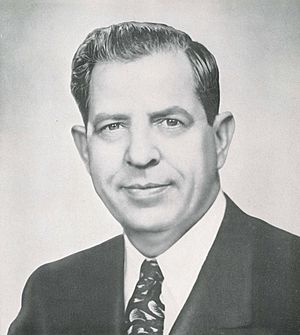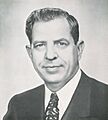Johnston Murray facts for kids
Quick facts for kids
Johnston Murray
|
|
|---|---|
 |
|
| 14th Governor of Oklahoma | |
| In office January 8, 1951 – January 10, 1955 |
|
| Lieutenant | James E. Berry |
| Preceded by | Roy J. Turner |
| Succeeded by | Raymond D. Gary |
| Personal details | |
| Born | July 21, 1902 Emet, Indian Territory, U.S. (now Oklahoma) |
| Died | April 16, 1974 (aged 71) Oklahoma City, Oklahoma, U.S. |
| Political party | Democratic (before 1956) Republican (after 1956) |
| Relatives | Bill Murray (Father) |
| Education | Murray State College Oklahoma City University (LLB) |
Johnston Murray (born July 21, 1902 – died April 16, 1974) was an American lawyer and politician. He served as the 14th governor of Oklahoma from 1951 to 1955. He was a member of the Democratic Party.
Johnston Murray was the first person with Native American heritage to be elected as a state governor in the United States. His mother, Mary Alice Hearrell, was a citizen of the Chickasaw Nation. His father, William H. Murray, also became a citizen of the Chickasaw Nation after marrying his mother. Johnston's father later became the ninth governor of Oklahoma (1931–1935).
As governor, Johnston Murray tried to lower state spending. However, state lawmakers did not always agree with his plans. The state constitution did not allow a governor to serve two terms in a row. His second wife, Willie Murray, tried to run for governor in 1954 but did not win. Johnston and Willie Murray later divorced.
After his time as governor, Murray worked for an oil company and a limousine service in Fort Worth, Texas. He later returned to Oklahoma City and worked as a lawyer. He also worked as a consulting attorney for the Oklahoma Department of Welfare. Both he and his father are buried in Tishomingo, Oklahoma.
Contents
Early Life and Education
Johnston Murray was born on July 21, 1902. His birthplace was the home of the Chickasaw Nation's Governor in Emet, which was part of Indian Territory at the time. Indian Territory was an area set aside for Native American tribes before Oklahoma became a state.
His mother, Mary Alice Hearrell, had Chickasaw heritage. Her uncle, Douglas H. Johnston, was a well-known Chickasaw Governor. Johnston Murray's father, William H. Murray, worked as a legal advisor for Governor Johnston. His father later helped write Oklahoma's constitution and became the ninth governor of the state.
Johnston Murray was one of five children. He went to public schools in Tishomingo, Oklahoma, which used to be the capital of the Chickasaw Nation. He graduated from Murray State School of Agriculture (now Murray State College) in 1924.
Even though he had Native American heritage, Johnston Murray never officially registered as a citizen of the Chickasaw Nation. Still, he is known as the first Native American to become a state governor in the U.S.
In 1923, Johnston Murray married Marion Draughon. They had one child and divorced six years later.
Early Career and Family
After college, Murray traveled to Bolivia with his father and brothers. They tried to start a large ranching business there. They lived in Bolivia for four years, but the project did not get enough support.
When Murray returned to Oklahoma, he worked in the oil and gas industry. He eventually became a plant manager.
After his first marriage ended, Murray married Willie Roberta Emerson in 1933. She was a talented concert pianist.
Political Journey
Murray became active in the Democratic Party, which was very strong in Oklahoma. In 1940, he was chosen as the chairman of the Oklahoma Electoral College. He also served as a member of the Electoral College in 1948. The Electoral College is a group of people chosen to formally elect the President and Vice President of the United States.
Murray also earned his law degree from Oklahoma City University School of Law in 1947. He held other political roles, like being the Democratic chairman for a part of Oklahoma and leading local political groups. He also worked for the Oklahoma Election Board.
Serving as Governor of Oklahoma
Johnston Murray became well-known through his political work and because his father was a famous former governor. He was elected Governor of Oklahoma in November 1950. He officially started his term on January 21, 1951. His 81-year-old father, "Alfalfa Bill" Murray, gave him the oath of office.
Murray's main promise during his campaign was to reduce state spending and lower taxes. He also wanted to continue improving education by combining schools. He aimed to change property taxes to give more money to local schools. He also supported expanding the state's highway and toll road systems.
During his time as governor, Murray worked with a state legislature that also had a Democratic majority. He vetoed (rejected) many bills that he disagreed with. He had several important successes:
- He was the first Oklahoma governor to be chosen as Chairman of the Southern Governors Conference.
- He helped fund the Turner Turnpike, a major highway that was finished in 1953 during his term.
- He played a key role in the state buying fairgrounds in Oklahoma City.
- In 1954, he traveled to Central and South American countries to represent the United States Information Service.
Johnston and Willie Murray
Willie Murray, Johnston's wife and Oklahoma's First Lady, was known for being charming and smart. She was also very ambitious. She opened the governor's mansion to the public every Thursday, welcoming thousands of visitors each week.
Being in office caused some problems between Murray and his wife. He felt she was too controlling.
Oklahoma's constitution did not allow a governor to serve two terms in a row. So, Johnston Murray could not run for governor again in 1954. Before his term ended, his wife Willie Murray announced that she would run for the office. Her campaign was seen as unusual. She was the first statewide candidate to campaign by helicopter.
After the 1954 election, Johnston Murray filed for divorce. Their divorce was finalized in 1956. Willie Murray received a payment, the family home, and a car. She also got a copy of the movie made about her campaign.
Later Life and Passing
Murray married for a third time to Helen Shutt in 1956. He lived and worked for a while in Fort Worth, Texas. There, he worked for an oil well service company and then a limousine service.
After returning to Oklahoma City, Murray started a law firm with Whit Pate in 1960. He ran for State Treasurer in 1962 but did not win.
Murray later worked as a consulting attorney for the Oklahoma Department of Public Welfare until he passed away on April 16, 1974. He is buried in Tishomingo, Oklahoma, alongside his parents.
See also
Images for kids


